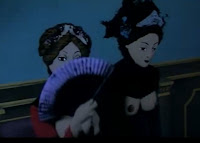While kicking up a riot at Scoundrels Chicago, I managed to break out and detox for a little over an hour in the mecca for all film reviewers - The Gene Siskel Film Center. I wandered in to the first film showing - which happened to be Joe Swanberg's mumblecore flick, UNCLE KENT. Just as its genre conventions require, UNCLE KENT is a low-budget lo-fi drama basically consisting of a bunch of financially comfortable but emotionally illiterate twenty and thirty somethings whining about their personal problems and jacking off. That might sound dismissive and I think the genre does have a tendency toward self-indulgence and baggy-narratives. However, when in the right hands it has managed to throw up movies of real warmth, depth and honesty. Think Alex Holdridge's IN SEARCH OF A MIDNIGHT KISS and the Duplass brothers' CYRUS - both of which made it to my Best Of lists.
Unfortunately, UNCLE KENT is no CYRUS. In fact, at a 72 minute run time including credits, it's barely a feature length film. It stars Kent Osborne (real-life animator on Spongebob Squarepants as "Kent" - a commitment-phobe jack-ass in the body of a forty-year old who dresses ten years too young. As with most mumblecore flicks, Kent espouses a kind of slacker freedom and mediates all his personal relationships through the internet. As the film opens, Kent picks up a girl called Kate (Jennifer Prediger) on Chatroulette - a website usually known for men jacking off on webcam - a point later demonstrated in the film. Still from such unpromising beginnings, the pair to seem to have a genuine connection. The tragedy is that they can only express it by having a threesome with a girl they meet on Craigslist. And as the weekend winds up, the downside of "slacker freedom" is painfully obvious to us and to Kent - not knowing where you stand - not being able to speak honestly about feelings, but constantly speaking openly about sex.
The movie looks better - more tripod shots - than in Swanberg's previous work, although he still uses POV shots and handheld cameras to annoyingly trite effect. The narrative is baggy and meandering and bores, even though the run-time is short. Most of all, while the movie did contain flashes of honesty about how my generation dates via the the web, it didn't really get under the skin of their emotional lives. One day, Swanberg is going to have to sit down and write a proper script and move beyond superficial "wisdom" about the distancing effect of the internet.
UNCLE KENT played Sundance 2011 and was released on a variety of media in the US earlier this year. It is currently playing at the Gene Siskel Center in Chicago.









































